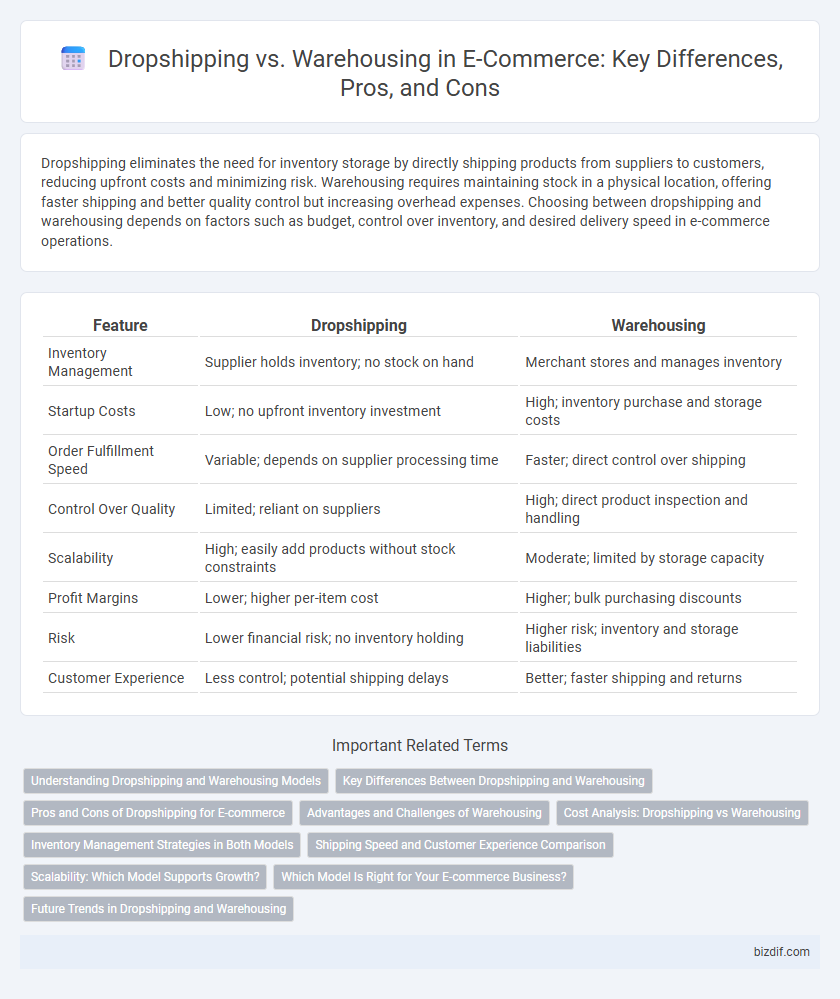Dropshipping eliminates the need for inventory storage by directly shipping products from suppliers to customers, reducing upfront costs and minimizing risk. Warehousing requires maintaining stock in a physical location, offering faster shipping and better quality control but increasing overhead expenses. Choosing between dropshipping and warehousing depends on factors such as budget, control over inventory, and desired delivery speed in e-commerce operations.
Table of Comparison
| Feature | Dropshipping | Warehousing |
|---|---|---|
| Inventory Management | Supplier holds inventory; no stock on hand | Merchant stores and manages inventory |
| Startup Costs | Low; no upfront inventory investment | High; inventory purchase and storage costs |
| Order Fulfillment Speed | Variable; depends on supplier processing time | Faster; direct control over shipping |
| Control Over Quality | Limited; reliant on suppliers | High; direct product inspection and handling |
| Scalability | High; easily add products without stock constraints | Moderate; limited by storage capacity |
| Profit Margins | Lower; higher per-item cost | Higher; bulk purchasing discounts |
| Risk | Lower financial risk; no inventory holding | Higher risk; inventory and storage liabilities |
| Customer Experience | Less control; potential shipping delays | Better; faster shipping and returns |
Understanding Dropshipping and Warehousing Models
Dropshipping is a retail fulfillment method where the store doesn't keep products in stock but transfers customer orders directly to a third-party supplier who ships items to the customer. Warehousing involves storing products in a dedicated facility, allowing businesses to manage inventory, packaging, and shipping internally. Understanding these distinct models is crucial for e-commerce entrepreneurs to optimize supply chain efficiency and balance upfront costs with control over fulfillment.
Key Differences Between Dropshipping and Warehousing
Dropshipping eliminates the need for inventory management by shipping products directly from suppliers to customers, reducing upfront costs and storage requirements. Warehousing involves purchasing, storing, and managing stock in a physical location, allowing for faster order fulfillment and greater control over inventory quality. Dropshipping offers flexibility with minimal risk, while warehousing demands higher capital investment but enables brand customization and bulk discount advantages.
Pros and Cons of Dropshipping for E-commerce
Dropshipping enables e-commerce businesses to minimize upfront inventory costs and reduce storage risks by directly shipping products from suppliers to customers, facilitating scalability and product variety. However, this model can lead to lower profit margins, limited control over inventory quality, and potential delays in fulfillment due to reliance on third-party suppliers. E-commerce entrepreneurs must weigh these advantages against issues like less brand control and increased dependency on supplier reliability when choosing dropshipping over traditional warehousing.
Advantages and Challenges of Warehousing
Warehousing offers businesses greater control over inventory management, enabling faster order fulfillment and improved product quality assurance, which enhances customer satisfaction. However, warehousing requires significant upfront investment in storage facilities, equipment, and staff, leading to higher operational costs and potential risks of overstocking or underutilization of warehouse space. Efficient warehouse management systems and accurate demand forecasting are essential to mitigate challenges and optimize inventory levels in an e-commerce environment.
Cost Analysis: Dropshipping vs Warehousing
Dropshipping minimizes upfront inventory costs by eliminating the need for bulk purchasing and storage, reducing capital expenditure and risk. Warehousing requires substantial investment in inventory, storage space, and handling logistics, leading to higher fixed and variable costs. Analyzing cost efficiency, dropshipping offers flexibility and lower overhead, while warehousing supports bulk purchasing discounts and faster fulfillment but with increased financial commitments.
Inventory Management Strategies in Both Models
Dropshipping relies on suppliers to manage inventory, eliminating the need for upfront stock investments and reducing storage costs, but introduces risks of stockouts and longer fulfillment times. Warehousing allows e-commerce businesses to hold products directly, enabling faster shipping and better quality control, yet demands higher capital for inventory purchases and storage space. Effective inventory management in warehousing involves accurate demand forecasting and real-time stock tracking, while dropshipping depends on strong supplier communication and dynamic inventory syncing to prevent overselling.
Shipping Speed and Customer Experience Comparison
Dropshipping often results in longer shipping times due to reliance on third-party suppliers, which can negatively impact customer satisfaction and repeat purchases. Warehousing, by storing products locally, enables faster order fulfillment and reliable delivery schedules, enhancing customer experience and boosting brand loyalty. Efficient inventory management in warehousing further ensures order accuracy, reducing return rates and increasing positive reviews.
Scalability: Which Model Supports Growth?
Dropshipping enables rapid scalability by eliminating inventory constraints and allowing businesses to offer a wide product range without upfront stock investment. Warehousing requires significant capital for storage space and inventory management but benefits from faster shipping times and better control over product quality. For sustained growth, dropshipping suits startups or businesses testing markets, while warehousing supports established e-commerce brands prioritizing customer experience and operational efficiency.
Which Model Is Right for Your E-commerce Business?
Dropshipping offers low upfront costs and eliminates inventory management, making it ideal for startups seeking flexibility and reduced risk. Warehousing requires higher investment but provides greater control over stock, faster shipping times, and better customer experience, suitable for businesses with steady sales volume. Assess order frequency, capital availability, and customer expectations to determine which model aligns best with your e-commerce growth strategy.
Future Trends in Dropshipping and Warehousing
Future trends in dropshipping emphasize increased automation and AI-driven inventory management to enhance order accuracy and delivery speed, reducing overhead costs significantly. Warehousing is shifting towards smart warehouses equipped with robotics and IoT technology to optimize stock control and fulfillment efficiency, supporting the growing demand for same-day shipping. Both models are integrating advanced data analytics to forecast demand more accurately, enabling better supply chain resilience and customer satisfaction in the evolving e-commerce landscape.
Dropshipping vs Warehousing Infographic

 bizdif.com
bizdif.com